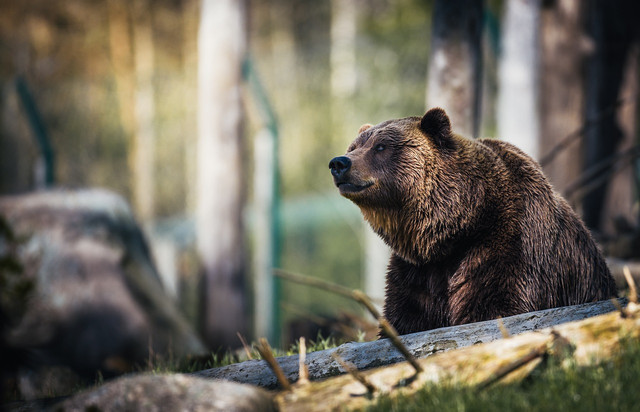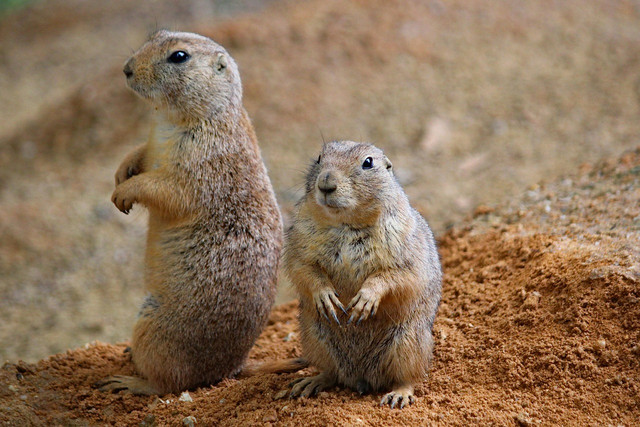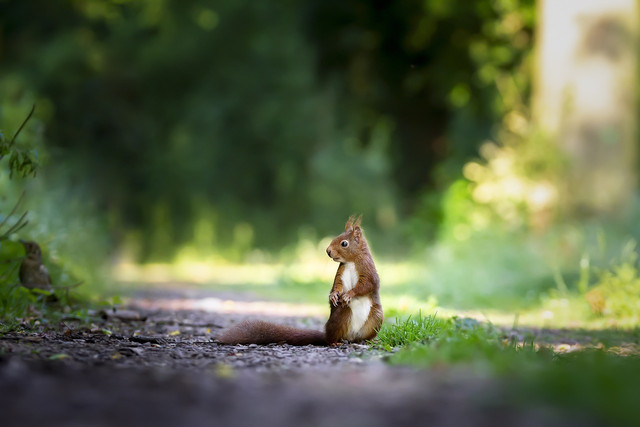Hibernation is not exclusive to bears, in fact, there are plenty of animals that hibernate in winter. We'll show you some of the most adorable ones.
Animals that hibernate in winter are incredibly adorable! But did you know that hibernation is actually essential for the survival of many animals? Hibernating can be a way of conserving energy to survive adverse weather conditions but it is also helpful when there is a lack of food. During hibernation, animals can go into a state called torpor where the body temperature of the animal drops to reduce the need for calorie intake and bodily functions slow down, such as their metabolism.
Despite what you may have heard, hibernation doesn’t always imply a long nap or deep sleep. In fact, many animals wake up in between, taking breaks to warm up their bodies or eat.
1. Bears



(Foto: CC0 / Pixabay / thepoorphotographer)
Bears are undoubtedly the most well-known animals that hibernate in winter! The multi-faceted, social, and intelligent giant furry creatures can be found throughout North America, South America, Europe, and Asia. Despite their cute and cuddly appearance, bears are often depicted as dangerous and unpredictable.
But let’s try to break this cliché. Bears are actually entirely predictable in their behavior, which makes encounters with humans less dangerous. Plus, they are incredibly tolerant and caring with fellow bears. Bears in warmer climates have no reason to hibernate, as they can access food all year. But those in colder climates hibernate when food is scarce. Towards the summer before hibernation, they double up on their food intake.
Bears choose spots like hollow trees, hillsides, or caves for their hibernation, or to get comfortable under the leaves and root systems of trees. They usually switch up the location every winter. According to the IUCN Red List, some bears are endangered. For example sloth bears, sun bears, polar bears, and Asiatic black bears.
2. Chipmunks



(Foto: CC0 / Pixabay / JillWellington)
These adorable tiny animals belong to the squirrel family and primarily live in North America, with some exceptions like the Siberian chipmunk living in Asia. You can recognize chipmunks by their brown and golden fur along with black and white stripes down their back.
They love to dig themselves burrows up until 3 feet under the ground for hibernation, located next to or under a cover to stay protected from predators and spend the cold winter months there. During the summer and fall, you may spot them with nuts between their cheeks to stock up on food, because they’re preparing for hibernation.
One of the most popular types of chipmunk is the Siberian chipmunk, which has a stable population. Unfortunately, some other types of chipmunks are endangered, for example, Palmer’s chipmunk and the Buller’s chipmunk.
3. Animals That Hibernate in Winter: Bats



(Foto: CC0 Public Domain / Unsplash - [Nils Bouillard])
Bats can be found almost anywhere in the world, except for the Arctic, Antarctic, and a few oceanic islands. Bats that already live in a warmer climate usually don’t hibernate, others simply fly toward warmer climates.
The animals that do hibernate in winter, usually settle down in wall spaces or dark and quiet caves. They also don’t shy away from living near humans and like to rest near houses or outside other buildings in hollowed trees or in barns.
While bats are often perceived as dangerous, they usually avoid closer contact with human beings. Bats are some of the only animals that can endure hanging upside down without their circulation being affected. That is possible because they don’t weigh a lot and carry little amounts of blood.
There are numerous different kinds of bats, and some, like the Giant Noctule, the Large-eared pied bat, and the Rennell flying fox, are endangered.
4. Box Turtles



(Foto: CC0 / Pixabay / micahzeb)
Box turtles can be found throughout North America, the eastern Gulf coast of Mexico, and the Yucatan Peninsula. While this differs per species, turtles generally go into hibernation around mid-September and mid-October for a period of around three to four months. Unlike some other animals that hibernate in winter — turtles don’t seek out particular locations for hibernation, but will just crawl inside their shell or dig a hole to rest in.
If you have box turtles at home, you’ll notice them being a little lazy than usual and eating less when hibernation is approaching. That’s partly because their gastrointestinal tract must be clear before hibernation. If you have box turtles as pets at home, don’t feed them during hibernation, but provide them with access to water, as they’ll occasionally take breaks to hydrate.
Unfortunately, a lot of turtles are endangered, such as the Eastern box turtle, the Burmese Roof turtle, and the Malayan Flat-shelled turtle.
5. Bumblebees



(Foto: CC0 / Pixabay / katja)
They are certainly not the first creature that comes to mind when thinking of animals that hibernate in winter. But have you ever encountered bumblebees in the winter? Okay, if you live in a warmer climate you may have, but in colder climates, it’s quite untypical! That is because bees go into hibernation.
More specifically, the queen bee goes into hibernation while the other bumblebees die around fall time — preparing herself to start her new colony in the spring. Unlike some of the other animals listed beforehand, the bumblebee does not take breaks to eat during hibernation, as she will fill up on enough pollen during spring and summer.
Bumblebees primarily live in the Northern Hemisphere, but can also be found in South America. European bumblebees have also been found in New Zealand and Tasmania. The so-called Confusing bumblebee, as well as the Half-black bumblebee, have a stable population, but overall bee populations are slowly declining. That’s why it’s important to plant flowers for bumblebees in your garden.
Many bumblebee species are endangered, including the American bumblebee, the yellow bumblebee, and the Ashton Cuckoo bumblebee. If bees go extinct, there will be negative implications for the entire planet.
6. Animals That Hibernate in Winter: Hedgehogs



(Foto: CC0 / Pixabay / Alexas_Fotos)
Hedgehogs are common all over the world, but can primarily be found in Europe, Asia, Africa, and New Zealand. While not all hedgehogs hibernate, those that do, don’t go into a very deep sleep and will regularly wake up for food in between (approximately every two to four days). They hibernate in sheds, old rabbit holes, compost heaps, under woodpiles, or amongst tree roots — the most important criteria being that it is warm enough!
Before going into hibernation, hedgehogs must reach a certain weight and store enough body fats to live through the hibernation period. There are stable populations of the Western European hedgehog, the so-called Erinaceus amurensis, and the Desert hedgehog, while others, like the Somali Hedgehog or the Brandt’s hedgehog are declining.
7. Lemurs



(Foto: CC0 / Pixabay / NickyPe)
Fat-Tailed Dwarf Lemurs live in the forests of western Madagascar and are popular animals that hibernate in winter. It is hard not to love these creatures with their tiny noses and big eyes. But what’s the story with their tails?
Fat-tailed Dwarf lemurs store the fat gained from foods they eat in their tail, resulting in their name “fat-tailed”. This stored-up fat becomes essential for survival during hibernation. Hibernation for them lasts for nearly six months! Unfortunately, lemurs belong to the most endangered species in the world.
8. Skunks



(Foto: CC0 / Pixabay / christels)
Skunks are mainly found throughout North America and Northern Mexico. While you may want to avoid them due to the offensive smell they can leave behind, they actually look adorable when all curled up for hibernation.
Unlike most of their furry friends, skunks prefer to be near houses during hibernation, so don’t be surprised if you find a skunk huddled together under your porch or even in your garage. These animals hibernate in winter between December and March.
While most skunk species are actually fairly populous, species like the Eastern spotted skunk are endangered. One of the reasons for that is that they seek to be close to humans, often crossing roads and inevitably colliding with vehicles while doing so.
9. Prairie Dogs



(Foto: CC0 / Pixabay / veverkolog)
Another interesting animal that hibernates is the prairie dog. Prairie dogs, unlike their name, usually resemble the size of a rabbit and are very social animals. They live together with their families and build themselves spacious homes and villages underground, which is also where they spend hibernation. They can mostly be found in the United States, Canada, and Northern Mexico.
While they don’t go to sleep during hibernation, they do slow down during the winter months and stay in their homes more often. Most populations of prairie dogs are endangered.
10. Animals That Hibernate in Winter: Ground Squirrel



(Foto: CC0 / Pixabay / eluxirphoto)
Ground squirrels can be found in North America, Africa, Eurasia, and Southeast Asia. Similar to chipmunks, ground squirrels love to forage in the open grasslands or grain fields, but it is no surprise either to spot them around residential areas or even on your balcony. Much like prairie dogs, they like to build underground tunnels for themselves.
This is also where they stay for hibernation. While they don’t fully fall asleep during hibernation — and will occasionally leave their homes, especially on a sunny day — ground squirrels typically hibernate from September to March. While some species of squirrels are endangered, ground squirrels have a stable population.
11. Groundhogs



(Foto: CC0 / Pixabay / franzschabreiter)
You may also know these adorable little creatures as “woodchucks”. Groundhogs are part of the squirrel family and are common in the United States and Canada. The chubby animals hibernate in winter, so spend their summer eating to build up layers of fat they need to survive the colder months. They usually stay active until October or November before they crawl into their burrows and start hibernation.
Besides eating enough, another step in preparing for hibernation is that females give birth to their babies early in the spring, so they have enough time to mature before hibernation comes around. There’s currently no danger of extinction for groundhogs.
12. Deer Mice



(Foto: CC0 / Pixabay / Alexas_Fotos)
Another example of adorable animals that hibernate in winter is deer mice. Deer mice primarily live in North America, Canada, and Mexico. You’ll recognize them by their light brown to red colors, little pointed noses, and huge black eyes. For hibernation, deer mice choose to build their nests from paper, fur, seeds, and more, usually under stones or logs, in attics or basements — not shying away from human habitat!
When they awake and get hungry, be prepared that deer mice may be on the hunt for some nuts, berries, seeds, or fruits. However, they’ll typically gather as much food as possible before hibernation begins to store it in their nests. While they typically avoid humans, you’ll often recognize they are around by the little trails they leave.
Deer mice are quite populous, so chances are high that you encounter them sooner or later. Make sure to refrain from using heavy chemicals, but rather try to get rid of mice naturally — there are many different ways.
13. Animals That Hibernate in Winter: Raccoons



(Foto: CC0 / Pixabay / klimkin)
Raccoons primarily live in North America, but can also be found in the northernmost regions of South America too. Like many of the previously introduced animals that hibernate in winter, raccoons take their prowl for food before hibernation pretty seriously. But they aren’t very picky with what they’re eating. In the fall, they start searching for an appropriate spot to hibernate in.
This location must meet two conditions: A warm temperature and protection from predators. Attics are not an uncommon spot for hibernation, as they will usually provide just that. Plus, raccoons can easily squeeze through tight spaces and have amazing climbing skills and strong hands.
To prevent them from coming in, make sure to secure your trash cans, remove and open food sources, or block access to hiding places where possible. Raccoon populations are actually on the decline, so while you may not want them in your home, it might be worth providing them a safe space for hibernation.
14. Garter Snakes



(Foto: CC0 / Pixabay / Nature-Pix)
Some may argue about the extent to which snakes are adorable, but garter snakes are actually one of the least dangerous snakes and some even choose to have them around as pets! Plus, they appear in beautiful colors — often with shades of yellow or green stripes down the front and underneath their bodies. It may surprise you that these animals hibernate in winter.
Garter snakes can be found from the subarctic plains of Canada to Costa Rica and typically hibernate in dens in their natural habitats: woodlands, grassy fields, and meadows. Many species of garter snakes are listed as endangered.
15. Ladybugs



(Foto: CC0 / Pixabay / DenisDoukhan)
The tiniest and most surprising of animals that hibernate in winter is probably the ladybug. Ladybugs can be found almost all over the world, but especially in Europe and North America. Technically, the term hibernation should rather be replaced with diapause for ladybugs, because they are cold-blooded insects. Only those living in colder climates enter diapause to avoid the risk of freezing.
While ladybugs usually live in grasslands, forests, cities, suburbs, or along rivers, for the cold months they seek a spot that offers them warmth and shelter. This could be under rotting trees, rocks, or even inside houses. Due to changes in climate and habitat loss, many ladybugs are endangered.
Read more:
- 10 Birds That Eat Spiders and How to Attract Them
- 5 Threats to Biodiversity and What You Can Do
- 16 Worst Invasive Species in the US
Do you like this post?












